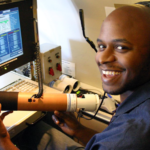MICHAEL ALISON CHANDLER
The Washington Post
WASHINGTON (AP) _ The images in the book were bright and the words simple, but many of the women in the classroom hesitated as they sounded out each sentence.
“If you can’t read the words, can you talk about the pictures?” teacher Elizabeth Bergner coached. The goal for the women enrolled in Bergner’s adult-education class in the District of Columbia is to learn English, but an equally important target is to help their children learn to read.
In a preschool classroom down the hall a few minutes later, the mothers had a chance to practice. They pulled their daughters and sons onto their laps and opened the book.
The District’s Briya Public Charter School enrolls parents and young children together in the same school, a novel effort to improve children’s prospects by building the skills of those who are closest to them. It’s an approach that an increasing number of researchers and philanthropists are promoting across the country as experts worry that investments in early childhood education or school improvement can only go so far.
“We spend a lot of money on poor children in our schools,” said Sharon Darling, president of the National Center for Families Learning. “But in reality, there are no poor children. They live with poor parents, and they are poor because they have poor skills. You can’t keep putting a Band-Aid on one part of the equation.”
Many modern school reforms emerge from the idea that schools can overcome the adversities children experience in their life outside of school. But dual-generation approaches _ in which parents are pursuing education in tandem with their children _ echo research that shows that a mother’s education is one of the strongest predictors of a child’s academic success.
Such programs provide support and training for parents to learn English, earn a degree or train for a better-paying job at the same time their children are taking their first steps or learning to read. Advocates hope they can give adults the ability to learn skills that will allow them to seek better jobs, earn more money and be more effective teachers for their children.
Building on the momentum of President Obama’s proposal to dramatically expand access to publicly funded preschool, advocates see an opportunity to consider investing simultaneously in parents. They cite brain research that documents the lasting negative effects of stress for young children living in poverty and economic analyses that show that even modest income gains for poor families can make a difference in the earning potential of their children later on.
Educators say it’s a far more complicated and expensive endeavor to educate adults and children together. Each group requires different training and expertise. And while children progress through preschool on a predictable timeline, adults juggling competing demands often take much longer to reach their educational goals.
But many say it’s a critical model in the 21st century, when the pace of economic inequality is overwhelming efforts to improve the quality of teachers and schools.
Almost half of children younger than 6 live in low-income families, and 1 in 4 come from families that meet the federal definition for poverty _ $23,850 for a family of four. Demographic changes, including an increase in households headed by a single parent and a growing Hispanic population, are affecting poverty rates. And research shows it’s difficult for children born at the bottom of the economic ladder to move up.
Anabel Cruz emigrated from Oaxaca, Mexico, 14 years ago and earned a living cleaning houses. After she had a child, she found herself unable to work, financially stretched and depressed. A social worker referred her to Briya in 2006, where she enrolled her son in a program for infants while she started learning English.
“Since then, I never stopped studying,” Cruz said. She earned a high school diploma and had two more children. Next month, she plans to graduate with a certificate to work as a medical assistant and expects to earn at least $16 an hour, twice what she was making before she went back to school. With improved language skills and a boost of confidence, she became a PTA president at her children’s school.
She credits the parenting classes at Briya with helping her to establish routines at home, discipline her children in a positive way and read with them every day.
“We talk about the sweet spot of mutual motivation,” said Anne Mosle, executive director at Ascend, an Aspen Institute program promoting two-generation approaches across the country.
Young parents find it extremely rewarding to be able to help their child with homework or better understand their teacher, she said, and it’s equally affirming “when a child sees a mom graduate.”
The idea of educating parents along with children is embedded in Promise Zones that are being created in poor neighborhoods across the country, offering concentrated services including prenatal care and career training. It’s the rationale behind federally funded home-visiting programs for families with infants and toddlers, and it has long roots in other anti-poverty programs.
Head Start has encouraged family engagement and skills-building since its inception in the 1960s. Parents are incorporated into the leadership of the programs, and all centers require parents to sign agreements listing personal goals for securing better jobs or housing. Some centers go much further in helping parents pursue their goals.
A program run by the nonprofit Community Action Project in Tulsa, Oklahoma _ now considered a national model _ helps parents enroll in community college and pursue jobs in health care. It pays tuition and supports parents with career coaches as well as cash incentives for good performance.
Darling, of the National Center for Families Learning, developed a dual-generation model to help poor families in Appalachia in the 1980s, putting parents on a bus with their young children so they could go to school together. Now her Louisville, Kentucky-based center supports similar programs on more than 40 Native American reservations and in schools in Lincoln, Nebraska; Springdale, Arkansas, and elsewhere.
Many efforts, including Briya’s, serve growing immigrant populations. Nationally, more than a third of Hispanic children _ the fastest-growing immigrant group _ live in families headed by an adult who did not graduate from high school.
The District school started in 1989 with a grant from Even Start, a federal program for dual-generation literacy that was later cut. It partnered with Mary’s Center, which provides social services and health care to many of the students. In 2006, it became a charter school and expanded to three sites. It now serves more than 400 adults and about 150 children.
Briya offers child care for infants and toddlers, while parents learn English and parenting skills, earn a high school degree or pursue job training. Some parents enroll their children in a full-day preschool program for 3- and 4-year-olds that the city funds.
The school has posted promising outcomes. While the vast majority of children in its preschool enter below widely held expectations on a nationally recognized preschool assessment, nearly 100 percent meet expectations when they leave. Parents in the English classes also outperform national averages on language-acquisition tests for English learners.
School officials say they have two advantages uncommon outside of the District _ a charter law that allows funding to flow to adult-education programs and some of the heftiest preschool investments in the nation.
Base per-student funding for the 2014-2015 school year in the District is $12,719 for 3-year-olds, $12,340 for 4-year-olds and $8,448 for adults.
School officials said that they verify that students are District residents but that they do not request information about immigration status. District law prohibits schools from denying admission to students of any age based on citizenship.
In an adult intermediate-English class at Briya, the parents’ goals were taped to the wall on sheets of paper: “To get a good job.” “To help my children.” “To talk to the doctor.”
Jenny Velasquez said she has worked mostly as a house cleaner or a cashier since moving from El Salvador to the United States. She tried to enroll in English classes several years ago, when she lived in Virginia, but could not commit because she did not have reliable child care. At Briya, she has been learning English for the past two years, many days while her daughters, ages 5 and 2, are in a classroom down the hall.
She also recently earned a Child Development Associate credential and is looking for jobs at day-care centers.
Her older daughter is starting kindergarten this year, and Velasquez said she feels confident about her skills. “She’s ready,” she said.
___
Information from: The Washington Post, http://www.washingtonpost.com










